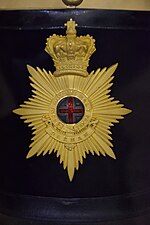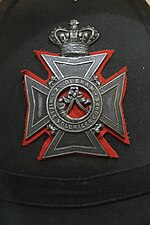Militia and Volunteers of County Durham
| Durham Militia | |
|---|---|

Shako plate of the Durham Militia, 1850's from the Durham Light Infantry museum
|
|
| Active | 1759—1908 |
| Country | Great Britain United Kingdom |
| Branch | Militia |
| Type | Infantry |
| Size | One Battalion to 1859 Two Battalions to 1908 |
| Engagements | Second Boer War |
| Disbanded | 1953 |
| Durham Fencibles and Volunteers | |
|---|---|

Home Service Helmet badge of the 2nd (Administrative battalion) Durham Rifle Volunteer Corps, pre 1881 from the Durham Light Infantry museum
|
|
| Active | 1758—1908 |
| Country | Great Britain United Kingdom |
| Branch | Volunteers |
| Type | Artillery, Cavalry, Infantry |
| Size | One Battalion 1758—1761 Multiple platoon to company size units 1792—1816 Five battalions 1861—1908 |
| Engagements |
Battle of Arklow Second Boer War |
| Disbanded | 1968 |
The Militia and Volunteers of County Durham are those military units raised in the County independent of the regular Army. The "modern" militia dates from legislation enacted during the Seven Years' War. The volunteers had several forms and separate periods of existence until made a permanent body in 1859.
After the invasion scare of 1745, and the later strain on the regular army during the Seven Years' War, bills for the reform of the militia were brought to parliament, but it was not until 1759 that the act would be passed (30 Geo II c.25). The act continued with the ballot to select men from each county, in numbers based on a return made by the county authorities of men of eligible age, initially between 18 and 50 years of age. As a substitute could be made on a payment of £10, the burden fell on the working classes. Subsequent explanatory legislation was required to curb rioting in 13 counties over fears of pay and overseas service, the militia would only be used in England and Wales. When not embodied (mobilised) for service the men had an annual training requirement of 28 days by 1762. The Legislation was continually amended, for example, by the end of the Napoleonic wars, to permit wider service in the country, fixed terms of service and paying a bounty for volunteering for the regular army.
The militia was under the control of the Lord Lieutenant of the county and was to be officered by the local gentry, their rank determined by a property qualification which was gradually reduced or ignored.
The regiment of the Durham Militia did not form until 1759, it was led by Henry Vane, 2nd Earl of Darlington, and had an initial strength of 369 men, with the headquarters at Barnard Castle (the Vanes lived nearby in Raby Castle). The first bandmaster of the regiment was William Herschel. The militia regiment in its early form was embodied on the following occasions:
The last annual training for balloted men was in 1825, and was held only once or twice in the next few years, as the militia was allowed to fall into disuse, and the Durham militia dwindled to only a small headquarters staff. At the end of 1833 this amounted to a captain, a serjeant-major (the captain's son), 12 serjeants, a drum-major and four drummers, and by 1844 was only the serjeant-major and six serjeants. In 1842 the Colonelcy of the militia had passed on to Henry Vane, 2nd Duke of Cleveland.
...
Wikipedia
